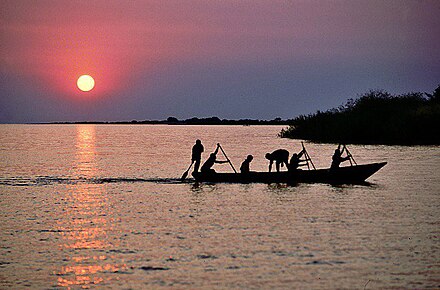Lake Tanganyika - lake in Africa
Lake Tanganyika is one of the Great Lakes of Africa. It is estimated to be the second largest freshwater lake in the world by volume, and the second deepest, in both cases, after only Lake Baikal in Siberia; it is also the world's longest freshwater lake.
Understand
 The lake is long (676 km, over 400 miles), narrow, and oriented approximately north-south. It borders four countries; most of the east coast is in Tanzania, but Burundi has a bit on the northeast while most of the west coast is in the Democratic Republic of the Congo, but Zambia has a bit on the southwest.
The lake is long (676 km, over 400 miles), narrow, and oriented approximately north-south. It borders four countries; most of the east coast is in Tanzania, but Burundi has a bit on the northeast while most of the west coast is in the Democratic Republic of the Congo, but Zambia has a bit on the southwest.
Towns on the lake include:
- Bujumbura 📍 — capital and largest city of Burundi, up near the northern tip of the lake
- Kigoma 📍 — northern terminus of the MV Liemba ferry route, on the east in Tanzania
- Kalemie 📍 — on the west side, in the DR Congo
- Lagosa 📍 — only a village but on the ferry route and starting point for journeys inland to Mahale
- Mpulungu 📍 — southern terminus of the MV Liemba ferry, in Zambia
Get in
It is possible to reach the lake via any of the neighbouring countries. Kigoma and Kalemie both have small airports and both are connected to their countries' rail networks. However the whole region has some safety risks and the DR Congo, especially the Katanga region where Kalemie is located and the Kivu region which also borders the lake, is particularly dangerous. See the country and region articles for details.
The nearest airport with a good selection of international flights is Dar es Salaam in Tanzania, and a common route to the lake is to fly there then take either plane or train to Kigoma. Alternately, Bujumbura has some international flights.
Other rail lines — from Bujumbura north to Kenya and Uganda, and from Mpulungu south to Lusaka — are being planned, but are not in service as of early 2015.
Get around
For the Tanzanian and Zambian part of the lake the best way of getting around is on the 100-year-old German-built ferry MV Liemba. The ship has become a legend among East and Central Africa travellers; some come to the lake mainly to sail on her. The ferry leaves Kigoma on Wednesday afternoons and arrives in Mpulungu in Zambia on Sunday. Another ferry connects Kigoma and Bujumbura.